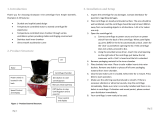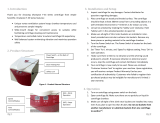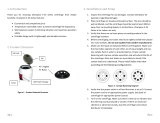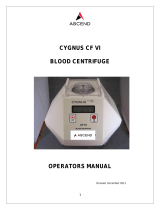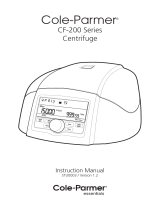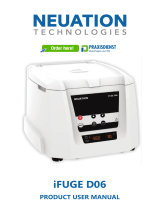
Laboratory Centrifuge Sigma 2-16P
Version 04/2007, Rev. 2.15 of 15/09/2017 • sb
Translation from the original operating manual, part no. 0700602
4 Storage and transport ....................................................................................................... 24
4.1 Dimensions and weight ................................................................................................... 24
4.2 Storage conditions .......................................................................................................... 24
4.3 Notes on transport .......................................................................................................... 24
4.4 Packaging ....................................................................................................................... 25
4.5 Transport safety device ................................................................................................... 25
5 Set-up and connection ...................................................................................................... 26
5.1 Installation site ................................................................................................................ 26
5.2 Power supply .................................................................................................................. 26
5.2.1 Type of connection .................................................................................................... 26
5.2.2 Customer-provided fuses ........................................................................................... 26
6 Using the centrifuge .......................................................................................................... 27
6.1 Initial start-up .................................................................................................................. 27
6.2 Switching the centrifuge on ............................................................................................. 27
6.2.1 Opening and closing the lid ........................................................................................ 27
6.2.2 Installation of rotors and accessories ......................................................................... 28
6.2.2.1 Installation of the rotor ........................................................................................ 28
6.2.2.2 Installation of angle rotors with a hermetically sealed lid .................................... 29
6.2.2.3 Installation of the microhaematocrit rotor............................................................ 30
6.2.2.4 Installation of accessories .................................................................................. 31
6.2.2.5 Adapters ............................................................................................................ 32
6.2.2.6 Tubes ................................................................................................................. 32
6.3 Control system "Spincontrol Universal" ........................................................................... 33
6.3.1 User interface ............................................................................................................ 33
6.3.2 Manual mode ............................................................................................................. 34
6.3.2.1 Starting a centrifugation run ............................................................................... 34
6.3.2.2 Interrupting a centrifugation run ......................................................................... 34
6.3.2.3 Interrupting a deceleration process .................................................................... 34
6.3.2.4 Selection, display, and modification of data ........................................................ 34
6.3.2.5 Runtime ............................................................................................................. 34
6.3.2.6 Speed ................................................................................................................ 36
6.3.2.7 Relative centrifugal force (RCF) ......................................................................... 36
6.3.2.8 Rotor selection ................................................................................................... 37
6.3.2.9 Softstart and softstop function ............................................................................ 37
6.3.2.10 Automatic lid opening function ("Auto-Lid-Open") ............................................... 38
6.3.2.11 Sound signal ("Buzzer") ..................................................................................... 38
6.3.2.12 Input lock ........................................................................................................... 38
6.3.3 Programs ................................................................................................................... 39
6.3.3.1 Saving the current settings ................................................................................. 39
6.3.3.2 Calling up stored programs ................................................................................ 39
6.4 Switching the centrifuge off ............................................................................................. 39




















